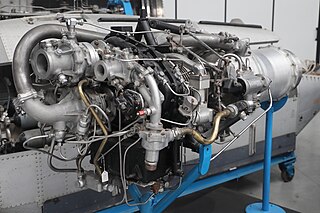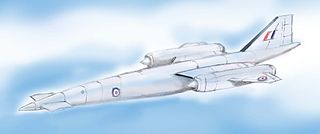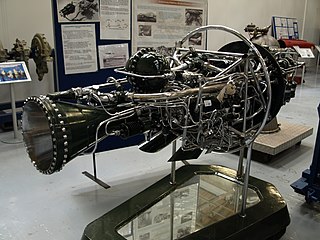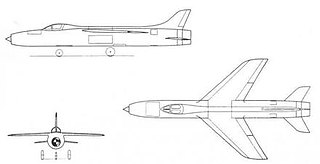
The Supermarine Scimitar was a single-seat naval strike aircraft designed and produced by the British aircraft manufacturer Supermarine. Operated exclusively by the Royal Navy's Fleet Air Arm, it was the final aircraft to be entirely designed and manufactured by Supermarine.

The Bristol 188 is a British supersonic research aircraft built by the Bristol Aeroplane Company in the 1950s. Its length, slender cross-section and intended purpose led to its being nicknamed the "Flaming Pencil".

The Saunders-Roe SR.53 was a British prototype interceptor aircraft of mixed jet and rocket propulsion developed for the Royal Air Force (RAF) by Saunders-Roe in the early 1950s. As envisaged, the SR.53 would have been used as an interceptor aircraft, using its rocket propulsion to rapidly climb and approach incoming hostile bombers at high speeds; following its attack run, the aircraft would then return to its base using jet propulsion.

The Saunders-Roe SR.177 was a 1950s project to develop a combined jet- and rocket-powered interceptor aircraft for the Royal Air Force (RAF) and Royal Navy. It was an enlarged derivative of the Saunders-Roe SR.53, which was itself an experimental combined jet-and-rocket interceptor aircraft.

The North American XF-108 Rapier was a proposed long-range, high-speed interceptor aircraft designed by North American Aviation intended to defend the United States from supersonic Soviet strategic bombers. The aircraft would have cruised at speeds around Mach 3 with an unrefueled combat radius over 1,000 nautical miles, and was equipped with radar and missiles offering engagement ranges up to 100 miles (160 km) against bomber-sized targets.
The Tupolev Tu-125 was an unrealized project to develop a new long-range supersonic bomber for the Soviet Air Force. Development commenced in 1958 to replace the newest Tu-22. The "Tu-125" designation was an internal one used by the Tupolev design bureau. Since the aircraft was never built, it never received a military designation.
The Grumman G-118 was a design for an all-weather missile-armed interceptor aircraft for use on US Navy aircraft carriers. Originally conceived as an uprated F11F Tiger, it soon evolved into a larger and more powerful project. Although two prototypes were ordered in 1955, development was cancelled the same year in favor of the F4H Phantom II before any examples were built. Grumman's next carrier fighter would be the F-14 Tomcat, ordered in 1968.

The de Havilland PS.23 or PS.52 Gyron, originally the Halford H-4, was Frank Halford's last turbojet design while working for de Havilland. Intended to outpower any design then under construction, the Gyron was the most powerful engine of its era, producing 20,000 lbf (89 kN) "dry", and 27,000 lbf (120 kN) with reheat.

The de Havilland Spectre is a rocket engine that was built by the de Havilland Engine Company in the 1950s. It was one element of the intended mixed power-plant for combination rocket-jet interceptor aircraft of the Royal Air Force, such as the Saunders-Roe SR.177.

The Short SA.4 Sperrin was a British jet bomber design of the early 1950s, built by Short Brothers and Harland of Belfast. It first flew in 1951. From the onset, the design had been viewed as a fall-back option in case the more advanced strategic bomber aircraft, then in development to equip the Royal Air Force's nuclear-armed V bomber force, experienced delays; the Sperrin was not put into production because these swept-wing designs, such as the Vickers Valiant, were by then available.

The Avro 730 was a planned Mach 3 reconnaissance aircraft and strategic bomber that was being developed by Avro Aircraft for the Royal Air Force (RAF). It had been originally envisioned as a very high-speed aircraft to perform aerial reconnaissance missions, conforming with the requirements of Air Ministry Specification OR.330. Avro subsequently decided to modify the design of the proposed 730 in order to accommodate its arming with nuclear weapons; this change therefore meant that the type would be able to perform the nuclear weapons delivery mission as well, which had been called for under Air Ministry Specification RB.156T which sought a high speed reconnaissance-bomber aircraft.

Operational Requirement F.155 was a specification issued by the British Ministry of Supply on 15 January 1955 for an interceptor aircraft to defend the United Kingdom from Soviet high-flying nuclear-armed supersonic bombers.

The Armstrong Siddeley Screamer was a British rocket engine intended to power the Avro 720 manned interceptor aircraft. Thrust was variable, up to a maximum of 8,000 lbf (36 kN).

The Leduc 022 was the prototype of a mixed-power French interceptor built in the mid-1950s. Designer René Leduc had been developing ramjet-powered aircraft since before World War II and had flown a series of experimental aircraft, the Leduc 0.10 and Leduc 0.21, throughout the Fifties before he was awarded a contract for two examples of a short-range supersonic interceptor armed with two air-to-air missiles (AAMs).

The Hawker P.1121 was a British supersonic fighter aircraft designed, but never fully completed, by Hawker Siddeley during the mid-1950s. It was designed by a team headed by Sir Sydney Camm.

The Avro 720 was an in-development British single-seat interceptor of the 1950s. It was designed and being developed by Avro in competition with the Saunders-Roe-built SR.53. While at least one prototype was partially-constructed, the order for the Avro 720, and quickly thereafter the project entirely, was terminated prior to any aircraft having been completed.

The Vought/General Dynamics Model 1600 series was a fighter aircraft proposal designed for the United States Navy's Navy Air Combat Fighter (NACF) program. The Model 1600 was a carrier-based derivative of the General Dynamics F-16 Fighting Falcon, but lost to the Northrop/McDonnell Douglas F/A-18 Hornet.

The Hawker P.1103 was a design by Hawker Aircraft to meet the British Operational Requirement F.155; it did not progress further than the drawing board.

The Supermarine Type 525 was a British prototype naval jet fighter aircraft of the 1950s.

The Supermarine Type 553 was a British Mach 2 research aircraft project from 1953 that never proceeded beyond the initial proposal.


















